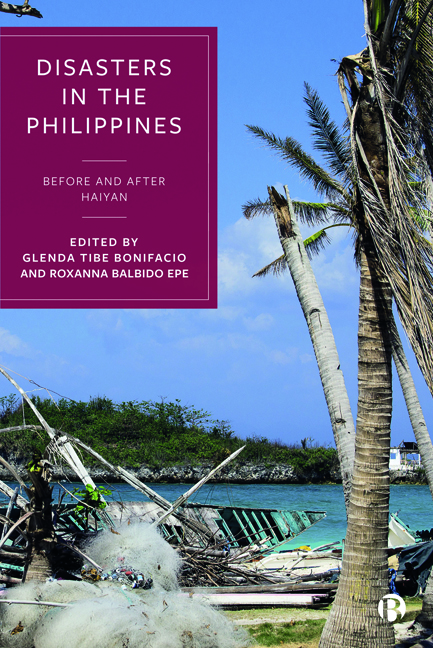9 - What Could Have Been? Disaster Impact Analysis of Haiyan in Region VIII
Published online by Cambridge University Press: 18 January 2024
Summary
Introduction
Typhoon Yolanda, internationally known as Haiyan, is one of the most devastating calamities that the Philippines had suffered in the last 20 years. With sustained winds of 295kph and gusts of 360kph, Haiyan hit the Visayan provinces (Eastern Samar, Leyte, Cebu, and Iloilo) on November 8, 2013, and was classified as a Category 5 hurricane, earning the super typhoon epithet (Mullen 2013). With six total landfalls in the different Visayan islands, Haiyan affected over 16 million individuals and left over 6,300 dead, over 1,000 missing, and 28,688 people injured (NDRRMC 2013, 2– 3). Overall, super typhoon Haiyan resulted in estimated total damage amounting to PHP89.6 billion and estimated losses of PHP42.76 billion. The area worst hit by the super typhoon was the Eastern Visayas (Region VIII), particularly Leyte, with over 5 million people affected (31.19% of the total 16 million), 5,902 (93.68%) dead, 1,005 (94.72%) missing, and 26,186 (91.28%) injured. A total of 492,856 (43% of the total) houses were destroyed, of which 248,306 were partially damaged while 244,550 were completely wiped out (NDRRMC 2013, 3– 4). In Region VIII alone, PHP4.99 billion was the total amount of damages in infrastructure; PHP18.92 billion in the productive sector; PHP41.89 billion in the social services sector; and PHP2.9 billion crosssectoral.
Total damages for the region reached PHP68.7 billion or almost 72% of the total damages of typhoon Haiyan in the Philippines (NDRRMC 2013, 148). But we argue that these are not the only costs brought about by the typhoon. In this chapter, we present a new approach to identifying and estimating disaster impacts such as that of typhoon Haiyan in Region VIII, focusing on the region's economy.
On November 11, 2013, then-President Benigno S. Aquino III declared a State of National Calamity and sent three C130 aircraft to Tacloban City, Leyte, carrying personnel, relief goods, and a communications van. The Department of Trade and Industry (DTI) declared a price freeze in the affected areas (Official Gazette n.d.) and within the first week after Haiyan's onslaught, the Department of Social Welfare and Development (DSWD) established a Donations Desk at the national and regional levels and prepositioned emergency relief resources worth PHP206.58 million (readily available for augmentation) which consists of 1) PHP66.18 million— standby funds; 2) PHP31.06 million— which translates to 16,115,448 food packs; and 3) PHP109.33 million— other food and non-food items.
- Type
- Chapter
- Information
- Disasters in the PhilippinesBefore and After Haiyan, pp. 179 - 197Publisher: Bristol University PressPrint publication year: 2023



